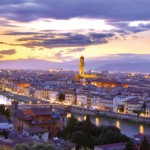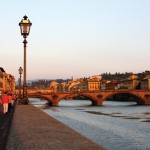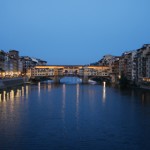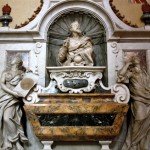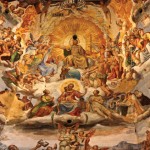The 147-foot-wide vault at the end of the cathedral’s nave garners the most attention among those touring the church. Here, at the order of Cosimo I, the ceiling was covered between 1568 and 1579 with a mosaic of restored frescoes collectively called The Last Judgement. Although Renaissance experts consider them as a whole to be “uninspired,” due mainly to the fact that they are the work of more than one artist and therefore inconsistent in technique and vision, the frescoes are colorful and individually spectacular. The initial painter, a Tuscan artist, historian and architect named Giorgio Vasari, managed to finish only the upper portion (near the lantern) of the mosaic before his death in 1574. One of Vasari’s more famous projects, however, was completed during his lifetime and spans a sizable section of the city: an elevated passageway extending from Palazzo Vecchio and the Uffizi to the Palazzo Pitti, built solely for the privacy of the Medicis. Clearly seen from many points on either side of the Arno, the corridor can be toured through advance bookings with the Uffizi.
Visitors are permitted to climb to the top of the Duomo, but I recommend ascending the campanile instead, which I did on my last day in Florence. At 278 feet tall, the bell tower’s topmost floor is nearly just as high as the dome’s lookout, and the 414-step trek is no doubt far more comfortable, since you can stop periodically at each of the open-air upper levels. The campanile’s line is also consistently shorter, and when I started, there wasn’t any line at all.
From this bird’s-eye perspective, complete with sweeping views, I was able to take in Florence’s Renaissance aces all over again, looking down at Ponte Vecchio and the river; across to Palazzo Pitti and its lush gardens; down at the lively Piazza della Signoria; and beyond the square to the Uffizi, in which the works of the great Donatello, Raphael, Botticelli, Caravaggio and their contemporaries live on. Of course, also visible from the top of the campanile is the grand Duomo, which during the course of history has seen some of Florence’s and the world’s most prominent residents and events.
I admit, sometimes it can be difficult to find present-day relevance in a city so ancient and renowned that its reputation precedes it. There may still be some who wonder if Florence isn’t just famous for being famous. After all, before my visit, I already could have told you that “David” is supposed to be stunning, the Duomo is said to be colossal, and the collection at the Uffizi is reportedly beyond impressive. But as they say, and as I discovered … seeing is believing.
Excursions
Castello di Verrazzano
For a true taste of the Tuscan good life, spend a day at Castello di Verrazzano, a late-Renaissance castle and winery perched atop a hill in the Chianti Classico area. Verrazzano.com
Siena
Only 75 kilometers south of Florence, Siena charms visitors with its medieval cityscape and expansive, shell-shaped Piazzo del Campo — the site of the famous Palio horse races each summer.
San Gimignano
On the way to or back from Siena, consider stopping in San Gimignano, dubbed “the Medieval Manhattan” for its 14 towers of varying height.
Cinque Terre
Along the Italian Riviera coastline is the area called Cinque Terre, consisting of the villages Riomaggiore, Manarola, Corniglia, Vernazza and Monterosso al Mare. In these “five lands” you’ll find colorful homes built into the steep, rugged cliffs and breathtaking views overlooking the sea.
Shopping
Ceramics
Sbigoli Terrecotte SbigoliTerrecotte.it
Crafts & Furnishings
Maestri di Fabbrica MaestriDiFabbrica.it
Fine Foods & Wine
Enoteca Obsequium Obsequium.it
Jewelry
Angela Caputi AngelaCaputi.com
Alessandro Dari AlessandroDari.com
Leather Goods
Peruzzi PeruzziSpa.com
Il Bisonte IlBisonte.com
Monaco Metropolitano MonacoMetropolitano.com
Photography Prints
Archivi Fotografici Alinari alinari.com


